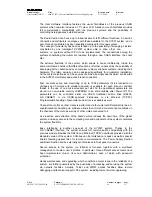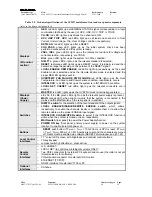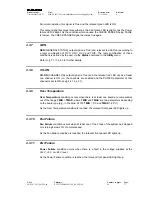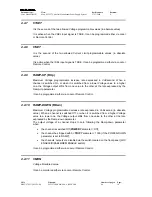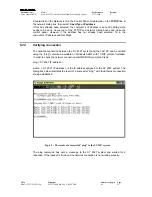
Document type:
Title:
Revision date:
Revision:
User's Manual (MUT)
Mod. SY2527, Universal Multichannel Power Supply System
27/11/2000
0
NPO:
Filename:
Number of pages:
Page:
00103/97:2527y.MUTx/00
SY2527USERMANUAL_REV0.DOC
84
25
In order to turn the channels on again, the user must remove the INTERLOCK condition.
Any attempt to turn the channels on without removing the INTERLOCK condition will
result unsuccessful.
4.2.9
HV SYNC
HVSYNC
is the synchronisation clock for the Power Supply Units (RS485 standard,
1.25 MHz). It can works either as MASTER (MASTER red LED on), i.e. the
synchronisation clock is internally generated and the HVSYNC connector works as
output, or as SLAVE (MASTER red LED off), i.e. the synchronisation clock is externally
generated and sent through the HV SYNC connector which works as input.
For the relative settings please refer to the
Set-Up
à
à
HV Clock Conf.
menu (§ 7.1.27,
p.69).
4.3
System status monitoring
Several output signals and alarms are available to monitor the system status, as
described in the following subsections.
Please note that all output signals mentioned below, unless differently specified,
are referred to a common ground (COMMON GROUND) and are galvanically
insulated up to 150 V with respect to the ground of the crate (CRATE GROUND).
For further details on electro-mechanical specifications of the components please refer
to the
Technical Specifications
Section in the
Hardware Installation Guide
. A short
summary of all front panel components is also given in Table 2.2 and Table 2.3 at
page 16 and 17, respectively.
For component location on the front panel please refer to the figure in Appendix A.
4.3.1
Over Current
The
Over Current
condition
(
OVC
) occurs when at least one channel is in
Over Current
condition, i.e. at least one channel has reached the current limit. The Over Current
condition is signalled by the OVC output signal True and the relevant red LED on.
The system detects this condition as a fault and reacts according to the setting of the
TRIP
parameter (see § 4.4.13, p.31 for its definition), namely:
1) TRIP = 1000
(
constant CURRENT mode
)
If the Board has programmable current hardware protections, the output voltage is
varied to keep the current below the programmed limit (I0SET or I1SET, according
to the ISEL signal level). The channel behaves like a current generator.
If the Board has fixed current hardware protections, the output current is permitted
to exceed the ISET value; the channel behaves like a current generator only if the
maximum current value is reached.
2) 0 < TRIP < 1000
(
TRIP mode
)
In this case, the channel behaves as in the constant CURRENT mode for a time
equal to the finite value set as TRIP parameter, and then it is switched off according

